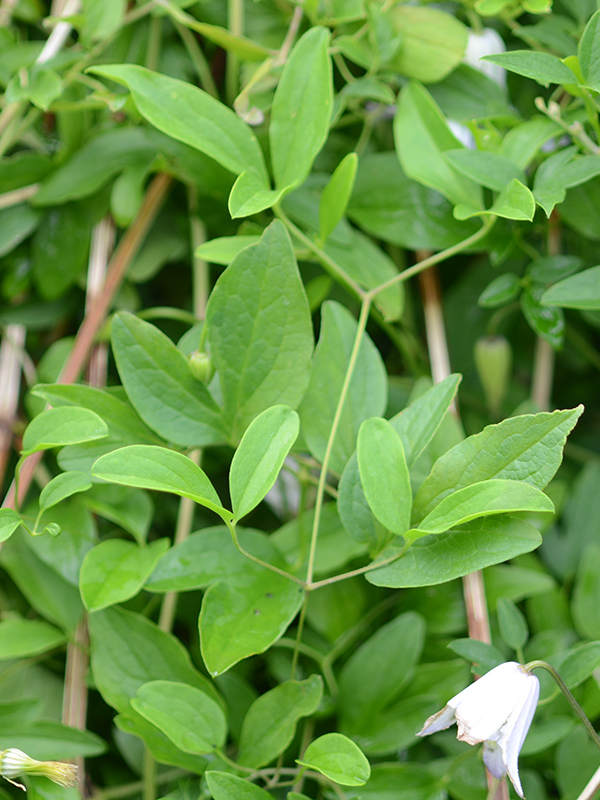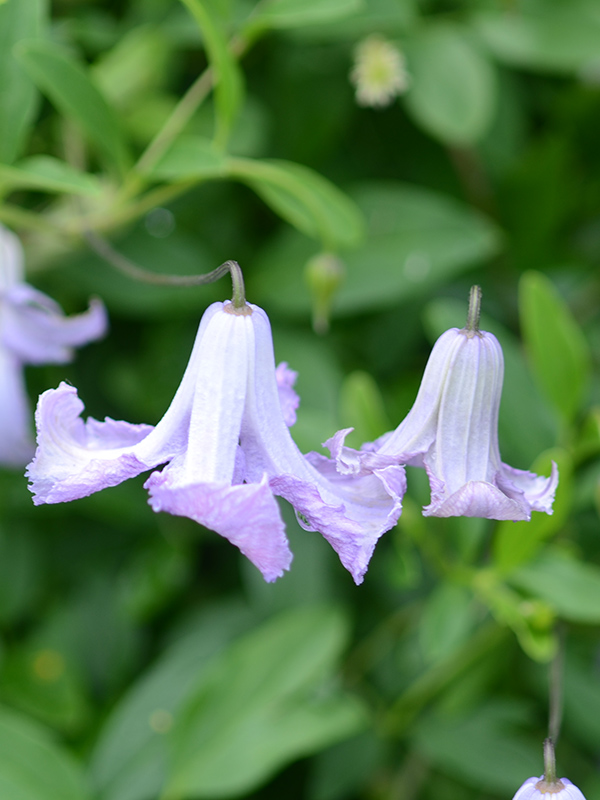
Woody > Clematis > Clematis 'Betty Corning'
Clematis
'Betty Corning'
Betty Corning Clematis
Origin: Clematis ‘Betty Corning’ was discovered in 1932 by Betty Corning. Betty Corning was involved in many regional and national garden organizations and was married to the Mayor of Albany New York. Corning discovered this cultivar which is thought to be a cross between the native C. crispa with C. viticella in the United States in 1932. DNA assays suggest the maternal plant was C. crispa and the paternal plant was C. viticella. In the experiment, the cultivar ‘Betty Corning’ showed a closer genetic relationship to the paternal parent than the maternal parent, suggesting that it is most similar to C. viticella.
Mike's
Opinion


"
Clematis ‘Betty Corning’ had been neglected in the landscape but has recently seen somewhat of a resurgence due in part to its beauty, hardiness, and tolerance to both colder and warmer climates. It flowers abundantly with the blooms exuding a slight tangerine scent which is especially notable on cool nights. The flowers are unique and attractive with their drooping, single, four-petaled bell shaped and pale-pinkish blue colour and white crossed blooms. It provides a stunning show throughout the summer and into early autumn because it produces hundreds of flowers on a somewhat compact vine.
Michael Pascoe, NDP., ODH., CLT., MSc. (Plant Conservation)
"
| Family |
| Ranunculaceae |
| Genus |
| Clematis |
| Cultivar |
| 'Betty Corning' |
| Category |
| Woody |
| Type |
| Vine |
| Pronunciation |
| USDA Hardiness Zone |
| 4 - 9 |
| Canadian Hardiness Zone |
| 2a |
| RHS Hardiness Zone |
| H7 - H3 |
| Temperature (°C) |
| (-32) - (-1) |
| Temperature (°F) |
| (-25) - 30 |
| Height |
| 1.5-2.5 m |
| Spread |
| 0.5-1 m |
Photographs
Description and Growing Information
Flowering Period
| General Description |
| Clematis ‘Betty Corning’ is a slightly fragrant clematis that has drooping pale pinkish-blue, bell shaped flowers. |
| Landscape |
| A plant with lightly scented flowers that will grow on a trellis, wall, arbour, fence or trees. In contrast to members of the Viticella group, it should not be used as a ground cover plant, as the attractive, bell-shaped, scented flowers cannot be completely appreciated. |
| Cultivation |
| Plants prefer full to partial sun with a cool shaded root zone with the crown being 5-8 cm deep in moist well drained soil. Prune in February or March (late winter to early spring) to encourage flowering on current seasons growth. This will also prevent flowering above eye level. |
| Shape |
| Spreading, climbing vine. |
| Growth |
| Fast |
| ID Characteristic |
| The identifying feature of this plant is its hundreds of 5 cm length four pale pinkish-blue flower petals that have a white cross inside the base and pale yellow anthers. |
| Pests |
| Pests such as caterpillars and aphids may feed on young shoots and foliage; earwigs may feed on the petals. Clematis wilt is caused by the fungus Phoma clematidina with the symptoms evident through wilting leaves, leaf stalks turning black and then with the stems starting to quickly wilt. There are no chemical controls available to treat Clematis Wilt. If an infection is apparent, cut the wilted stems back to the healthy tissue. Tools used should be disinfected thoroughly and removed infected tissue should be destroyed to prevent any further soil or plant infection. |
| Habitat |
| Horticultural origin. |
| Bark/Stem Description |
| Brittle; light to dark brown, thin bark. |
| Flower/Leaf Bud Description |
| Buds are a light green and teardrop shaped. |
| Leaf Description |
| The leaves are mid-green in colour, composed of 3 leaflets up to 6 cm in length. |
| Flower Description |
| Flowers are 5 cm in length and 5 - 6.5 cm across. They are lightly tangerine scented and have pale pinkish-blue flower petals that are pinkish mauve inside with a white cross at the base; bell-shaped and nodding with pale yellow anthers. |
| Fruit Description |
| The seed heads are plumose, light brown in colour and 2.5 - 3 cm in length. |
| Colour Description |
| In the growing season the leaves are a mid-green colour while the flower petals are a pale pinkish-blue. The bark is light to dark brown. |
| Texture Description |
| In the spring new growth is fine textured and becomes medium textured when mature; flowers are fine textured. |
| Notable Specimens |
| The A.M. Cuddy Gardens, Strathroy, Ontario, Canada. Montreal Botanical Gardens, Montreal, Quebec, Canada. |
| Propagation |
| Propagate by placing sections of younger stems under the soil (layering) to encourage new roots to form or by taking semi hardwood cuttings in late summer to mid-autumn. |
References
Armitage, Allan M. 'Armitage’s Vines and Climbers: A Gardener’s Guide to the Best Vertical Plants.' Portland, OR: Timber Press. 2010. Print.
Evison, Raymond J. 'Clematis For Small Spaces: 150 High-Performance Plants For Patios, Decks, Balconies And Borders.' Portland, OR: Timber Press. 2007. Print.

